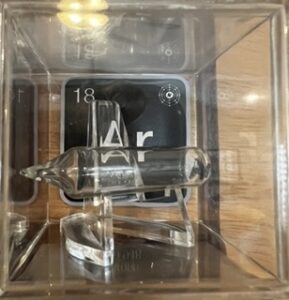Argon
Atomic Number: 18
Atomic Mass: 39.948 u

Argon, often overlooked in favor of more “active” elements, is a silent yet significant player in various modern applications. As a member of the noble gases in the periodic table, argon possesses unique properties that make it invaluable in many industries today. This blog post will explore the intriguing world of argon, its characteristics, and how it’s used in contemporary settings.
Understanding Argon
Argon, with the symbol ‘Ar’ and atomic number 18, is a colorless, odorless, and tasteless gas under normal conditions. It’s the third-most abundant gas in the Earth’s atmosphere, making up about 0.93% of it. Being a noble gas, argon is extremely inert, meaning it doesn’t easily react with other elements or compounds.
The Diverse Uses of Argon
1. Industrial Applications
- Welding: Argon is widely used as a shielding gas in welding. It protects the weld area from atmospheric gases such as oxygen and nitrogen, which could cause defects in the weld.
- Manufacturing: In manufacturing, argon is used to create an inert atmosphere where required, such as in the production of titanium and other reactive elements.
2. Lighting
- Incandescent Light Bulbs: Argon is used in incandescent light bulbs. It protects the filament from oxygen, prolonging the life of the bulb.
- Neon Lights: Although called ‘neon lights’, some of these actually use argon gas. When electrified, argon emits a characteristic blue light.
3. Preservation
- **
Historical Document Preservation**: Argon gas is used in the preservation of historically significant documents. For instance, the original copies of the U.S. Declaration of Independence and the Constitution are housed in enclosures filled with argon to prevent deterioration.
4. Medical and Scientific Uses
- Medical Equipment: Argon is used in various medical equipment for laser surgeries and to destroy tumors.
- Scientific Research: In scientific research, argon is used in Geiger counters and other radiation detection equipment due to its inert nature.
5. Food and Wine Industry
- Food Packaging: Argon is used in food packaging to displace oxygen and extend the shelf life of products. Its inertness makes it perfect for preventing food spoilage.
- Wine Production: In winemaking, argon is used to top off barrels and bottles to prevent oxidation of the wine, preserving its quality and flavor.
6. Aerospace and Aircraft
- Aerospace: In the aerospace industry, argon is used in the manufacturing process of aircraft components and spacecraft for its inert atmosphere.
Environmental Impact and Safety
Argon is a non-toxic, environmentally benign gas. It doesn’t contribute to global warming or ozone depletion, making it a preferred choice in applications where environmental impact is a concern. However, being a colorless and odorless gas, it can displace oxygen in closed spaces, posing an asphyxiation risk.
Conclusion
Argon may not share the fame of elements like oxygen or hydrogen, but its role in modern technology and industry is undeniable. From preserving the relics of history to lighting up our cities and aiding in advanced medical procedures, argon’s applications are both varied and vital. It’s a prime example of how even the most unreactive elements can have dynamic and critical roles in our everyday lives. As we continue to explore the potential of argon, its quiet presence is sure to be felt across an even broader range of applications.
For Kids
Hello, young scientists! Ready to explore the world of argon? This noble gas might be invisible, but it’s everywhere and has some super cool uses. Let’s dive into some fun facts about argon that will make you see this invisible gas in a whole new light!
- A Noble Gas: Argon is part of a special group of elements called the ‘noble gases’. They are called ‘noble’ because they are very ‘snobby’ – they hardly ever react with other elements!
- Third Most Common Gas: In the Earth’s atmosphere, argon is the third most common gas. It’s even more common than carbon dioxide! But, you can’t see it or smell it because it’s colorless and odorless.
- Discovered by Accident: Argon was discovered in 1894 by Sir William Ramsay and Lord Rayleigh. They found it by accident when they were trying to find out why nitrogen from the air was different from nitrogen in chemicals.
- Lighting Up the World: Some street lights use argon gas. When electricity passes through argon, it makes a pretty blue light. So, next time you see a blue streetlight, think of argon!
- Super Spacey: Argon isn’t just found on Earth; it’s also in space! Scientists have found argon on Mars, the moon, and even in distant stars.
- Preserving the Past: Argon is used to protect important historical documents. The United States’ Declaration of Independence and the Constitution are kept in cases filled with argon gas to stop them from aging.
- Under the Sea: Argon is used by scuba divers too! Mixed with other gases, it helps divers breathe more easily deep under the sea.
- A Welder’s Friend: Argon is really useful in welding. It protects the metals being welded from the air, which can cause them to react and not weld together properly.
- Not Just One Form: At super-cold temperatures, argon can turn into a liquid or even a solid. Imagine that – solid argon!
- Keeping Food Fresh: Argon is even used in food packaging. It keeps the air out and keeps food fresh for longer. So, it might have helped keep your snacks crispy!
Isn’t argon amazing? It’s all around us, helping in so many different ways – from lighting our streets to keeping history safe and even helping us explore under the sea. This invisible gas sure is a hidden hero of the periodic table! 🌟💨🔬
 using WordPress and
using WordPress and
No responses yet